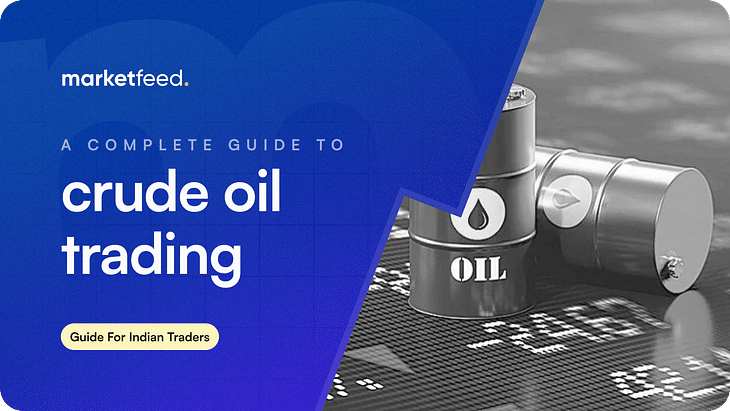A Simple Guide to Crude Oil Trading in India

Crude oil, often referred to as the "mother of all commodities," plays a significant role in global trade. From powering vehicles to forming the raw material for plastics and pharmaceuticals, crude oil impacts nearly every aspect of our lives. In this article, we explore the fundamentals of crude oil trading in India! We dive into why it’s a compelling market, the capital required, and the critical data points that impact the pricing of crude oil.
Why Trade Crude Oil?
One of the most attractive features of crude oil trading is the extended trading hours, making it ideal for individuals who work during regular market hours (9:15 AM to 3:30 PM). With trading sessions running from 5:00 PM to 11:30 PM in India, crude oil offers flexibility for traders constrained by daytime work commitments.
Crude oil also exhibits high volatility, creating opportunities for directional trades. Its global significance ensures consistent demand and its pricing can act as an indicator for other commodities and even stocks.
Crude Oil Benchmarks
Crude oil prices are determined by various benchmarks based on origin and quality. The three major benchmarks are:
1. West Texas Intermediate (WTI): Sourced primarily from the United States, this is the most widely traded crude oil benchmark.
2. Brent Crude: Extracted from the North Sea region, this benchmark serves as a reference for European and global markets.
3. Dubai Crude: Predominantly produced in the GCC (Gulf Cooperation Council) countries, it represents the Middle Eastern oil market.
The primary difference between these benchmarks lies in their geographical origins and levels of impurities.
Tracking WTI Crude Oil
For traders, WTI crude oil’s price movement is a key indicator. On platforms like TradingView, WTI is labelled as “US Oil” and provides valuable insights for market analysis. Observing technical patterns on WTI charts can help traders forecast movements in domestic crude oil contracts listed on the Multi Commodity Exchange (MCX).
Understanding Crude Oil Trading on MCX
Indian traders primarily access crude oil through MCX, which offers two types of contracts:
1. Crude Oil (Standard): Contract size of 100 barrels.
2. Crude Oil Mini: Contract size of 10 barrels.
You can trade crude oil in India using any broker that offers access to MCX trading - Zerodha, Angel One, Upstox, etc.
The crude oil market on MCX is highly active, with daily trading volumes exceeding ₹3,000 crores, equivalent to approximately 8,500 barrels. Both institutional and retail traders participate, with institutions often hedging their exposure in the physical market.
How Prices Are Determined
The price of crude oil on MCX is influenced by:
- WTI Crude Oil Price: The global benchmark.
- USD to INR Exchange Rate: Currency fluctuations directly impact domestic crude oil pricing.
- WTI Price: $78.2 per barrel
- USD/INR Exchange Rate: 86.62
MCX Crude Oil Price: $78.2 × 86.62 ≈ ₹6,777
Trading Hours
WTI crude oil trades globally until 2:00 AM IST, while MCX closes at 11:30 PM (or 11:55 PM during daylight savings). This discrepancy can lead to price gaps and requires traders to account for after-market developments in global markets.
Capital Requirements for Trading Crude Oil
- Crude Oil (Standard): Requires a margin of approximately ₹3.32 lakhs for one lot.
- Crude Oil Mini: Requires a margin of around ₹33,340 for one lot.
For options traders, the required margin depends on the premium and lot size. Be cautious with options, as lower liquidity in the Indian market can lead to challenges in exiting trades, particularly if contracts are deep in-the-money.
Key Data Points to Monitor
Before diving into crude oil trading, closely monitor these factors:
1. Geopolitical News: Global events like conflicts or OPEC meetings can significantly impact oil prices.
2. Supply and Demand Data: Regular reports, such as the U.S. Energy Information Administration (EIA) inventories, influence short-term price movements.
3. Technical Indicators: Utilise tools like moving averages, trendlines, and support/resistance levels to forecast price patterns.
4. Currency Fluctuations: USD/INR movements can amplify or dampen the effects of international crude oil price changes.
Trading Strategies for Crude Oil
1. Futures Trading: Ideal for capturing directional moves in the market. However, ensure you understand margin requirements and risk management.
2. Options Trading: Provides flexibility but requires caution due to liquidity constraints in the Indian market.
3. Correlation Trades: Use crude oil trends to influence trades in related stocks or sectors, such as energy or logistics.
4. Hedging: For advanced traders, crude oil can serve as a hedging instrument against exposure to other assets.
Practical Tips for Beginners
- Start Small: Begin with Crude Oil Mini contracts to limit risk.
- Paper Trade: Use demo accounts to familiarise yourself with the market.
- Stay Updated: Regularly monitor news and technical analysis platforms like TradingView.
- Avoid Holding Positions Overnight: Gaps between global and domestic market hours can lead to unexpected losses.
- Hedge Your Bets: Always consider strategies to minimise risk, especially in volatile markets.
Conclusion
Trading crude oil could be rewarding for disciplined and informed traders. Its global significance, high volatility, and accessibility on platforms like MCX make it a preferred choice for many. By understanding benchmarks, monitoring essential data points, and employing sound strategies, you can navigate the complexities of crude oil trading with confidence.
Embark on your journey into crude oil trading today and harness its potential for growth. Remember, informed decisions and consistent learning are key to success in this dynamic market.
Also Read: A Beginner's Guide to Commodity Trading in India
Disclaimer: Trading in commodities, including crude oil, involves risk and may not be suitable for all investors/traders. The information provided in this guide is for educational purposes only and should not be considered as financial, investment, or trading advice.


Post your comment
No comments to display